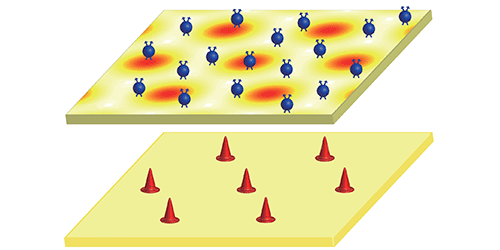Tickled by a Wigner Crystal
Left to their own devices, electrons confined to a sheet can crystallize into an ordered array at low temperatures because of their mutual repulsion. Physicists have observed a classical version of this “Wigner crystal” in electrons floating on liquid helium and a quantum variety in electrons trapped at a semiconductor interface. But the lattice geometry of electrons in the latter has been tough to glean. A team led by Mansour Shayegan at Princeton University, New Jersey, obtained this information using a new technique, possibly providing a way to test the many-body theories that predict Wigner crystallization.
The experimental device consists of a stack of two closely spaced semiconductor quantum wells. Electrons in quantum wells are effectively trapped in 2D, and at high magnetic fields and low temperatures they fall into quantized orbits. These states are the basis of the fractional quantum Hall effect (FQHE), whose signature is sharp dips in the resistance at fractional values of the so-called filling factor (the ratio of electron density to field strength).
The team fabricated the top and bottom quantum wells in the stack with different electron densities, choosing densities such that the bottom well didn’t exhibit the FQHE, while the top one did in the researchers’ chosen range of magnetic fields. At low temperatures (less than about 1 K), they observed dips in the top well’s resistance indicating the FQHE. But below 200 mK, the researchers also saw additional shallow resistance wiggles. They could explain the placement of these new features if the electrons trapped in the top well experienced a periodic potential from a triangular-lattice Wigner crystal in the bottom well.
This research is published in Physical Review Letters.
–Jessica Thomas
Jessica Thomas is the Editor of Physics.





